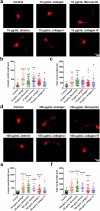Type I collagen extracellular matrix facilitates nerve regeneration via the construction of a favourable microenvironment
- PMID: 39659559
- PMCID: PMC11631217
- DOI: 10.1093/burnst/tkae049
Type I collagen extracellular matrix facilitates nerve regeneration via the construction of a favourable microenvironment
Abstract
Background: The extracellular matrix (ECM) provides essential physical support and biochemical cues for diverse biological activities, including tissue remodelling and regeneration, and thus is commonly applied in the construction of artificial peripheral nerve grafts. Nevertheless, the specific functions of essential peripheral nerve ECM components have not been fully determined. Our research aimed to differentially represent the neural activities of main components of ECM on peripheral nerve regeneration.
Methods: Schwann cells from sciatic nerves and neurons from dorsal root ganglia were isolated and cultured in vitro. The cells were seeded onto noncoated dishes, Matrigel-coated dishes, and dishes coated with the four major ECM components fibronectin, laminin, collagen I, and collagen IV. The effects of these ECM components on Schwann cell proliferation were determined via methylthiazolyldiphenyl-tetrazolium bromide (MTT), Cell Counting Kit-8, and 5-ethynyl-2'-deoxyuridine (EdU) assays, whereas their effects on cell migration were determined via wound healing and live-cell imaging. Neurite growth in neurons cultured on different ECM components was observed. Furthermore, the two types of collagen were incorporated into chitosan artificial nerves and used to repair sciatic nerve defects in rats. Immunofluorescence analysis and a behavioural assessment, including gait, electrophysiology, and target muscle analysis, were conducted.
Results: ECM components, especially collagen I, stimulated the DNA synthesis and movement of Schwann cells. Direct measurement of the neurite lengths of neurons cultured on ECM components further revealed the beneficial effects of ECM components on neurite outgrowth. Injection of collagen I into chitosan and poly(lactic-co-glycolic acid) artificial nerves demonstrated that collagen I facilitated axon regeneration and functional recovery after nerve defect repair by stimulating the migration of Schwann cells and the formation of new blood vessels. In contrast, collagen IV recruited excess fibroblasts and inflammatory macrophages and thus had disadvantageous effects on nerve regeneration.
Conclusions: These findings reveal the modulatory effects of specific ECM components on cell populations of peripheral nerves, reveal the contributing roles of collagen I in microenvironment construction and axon regeneration, and highlight the use of collagen I for the healing of injured peripheral nerves.
Keywords: Chitosan nerve conduit; Collagen I; Collagen IV; Extracellular matrix; Peripheral nerve regeneration; Regenerative microenvironment; Scaffold.
© The Author(s) 2024. Published by Oxford University Press.
Conflict of interest statement
None declared.
Figures










References
LinkOut - more resources
Full Text Sources

